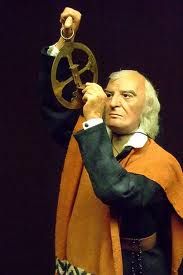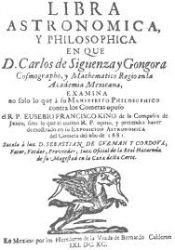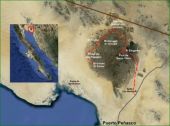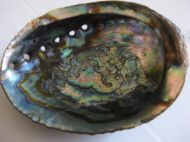Astronomer, Cartographer, Volcanologist and Agriculturist,
Kino Scientist
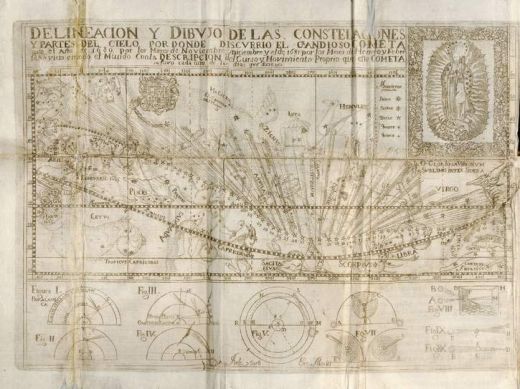
Kino's Hand Drawn Sky Map of Great Comet of 1681
Astronomer
Astronomical Observations of The Great Comet 1680 - 1681
Kino precisely charted the position on a daily basis of the route of the Great Comet of 1680 where it appeared in the sky in November and December 1680 and in January through March 1681. Issac Newton in his "Principia" used observations of the Great Comet to verify Kepler's laws of planetary motion. Newton's "Principia" was published in 1687, the year that Kino began his 24 years of work in the Pimeria Alta. The Great Comet is also known as Kirsch's Comet.
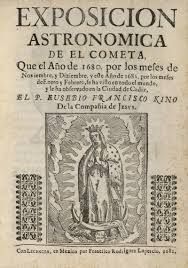
The Astronomical Exposition of The Comet - Front Cover
Comet Treatise
Kino wrote the one of the first astromical treatises of the New World during his 5 month stay in Mexico City before leaving for Baja Califorina as a missionary and the Royal Cosmographer of the Atondo Expedition. Printed in Mexico City in 1681.
Kino's Original Facsimile Copy of
"Exposición Astronómica del Cometa"
For facsimile copy of Kino's original "Exposición Astronómica del Cometa" ("The Astronomical Exposition of The Comet") from the online Biblioteca Virtual Miguel de Cervantes in Alicante, click
http://www.cervantesvirtual.com/nd/ark:/59851/bmc959v2
Then to view click "html" button in lower left at the bottom of the screen with "leer obra" underneath button.
Kino's Response to the Sigüenza-Kino Comet Controversy
"To the Kind Reader:
I beg the Sovereign Lord that this small treatise will enjoy a better fortune than my "Exposición Astronómica del Cometa de 1680 y 1681." Don Carlos de Sigüenza was deeply offended, saying in his "Libra Astronómica" that I wrote my "Exposición Astronómica" against his "Manifesto Philosóphico." Never did I think of writing or publishing a word against the "Manifesto Philosóphico." Neither do I recall reading it nor would I have failed to have had a scruple about wasting time so precious and necessary for better and more exacting occupations, such as those which have brought me to the Americas. I have too much before me to concern myself with debates and recriminations of little value and edification. Don Carlos de Sigüenza wrote against my "Exposición Astronómica" with a superfluous meticulously inasmuch as I wrote that book at the request and instance of some Fathers and gentlemen friends in Mexico City during the few weeks of my stay there.
I even received gratitude for it from Rome. Approbations came from the learned Fathers Francisco Jiménez and Francisco Florencia, and especially, from the very erudite and able religious Mother Juana Inés de la Cruz, professed of the Order of San Jerónimo, who in her ingenious and learned volume, endorsed it with special verses, supporting and defending it with apparent sufficiency.
Wherefore, I beg my kind reader to be persuaded that I do not intend to treat anyone rudely. Rather, I propose to communicated to all in a friendly way the good news concerning what His Divine Majesty is pleased to do and perform in these farthest reaches of the New World. I openly declare that, as I do not want the least expression in this booklet of mine to detract one bit from the holy opinion and judgment of Our Holy Mother Church, of the Inquisition or of our holy Faith, so certainty I do not desire that his work should contain the least thing, whatever it might be, that would be against the love of God or of my dear fellowman."
Eusebio Francisco Kino
Prologue
"Opinions about the Missionary Apostolate By Venerable Francisco Javier Saeta,
Taken From His Letters and Religious Conversations" 1695
From "Kino's Biography of Francisco Javier Saeta"
Dr. Ernest J. Burrus, S.J., Translator and Editor
Editor Note: Kino wrote about the Sigüenza-Kino Comet Controversy in 1696 in the prologue to his "Biography of Father Saeta" in order to counter the attacks of those who wished to recall him from his decade-long work in the Pimería Alta. In the Saeta Biography which Kino presented to the highest secular and religious authorities in Mexico City, Kino defends the Native people and explains the causes of the Tubutama Uprising and the reasons why he should continue his mission work. Five years before Kino's summons to Mexico City and 15 years after the publication of Kino's "Exposición Astronómica," Sigüenza wrote his "Libra Astronómica" where Sigüenza expresses his opinon that Kino had belittled the scientific knowledge of Mexican-born Spaniards when he disagreed with the ideas of a scientific faction lead by Sigüenza.
For more about Kino's Saeta Biography and the Tubutama Uprising, click
Missionary Page and
Ride for Justice Page
Kino refers to the genius and savant Sor Juana de Inés as supporting his "Exposición Astronómica." Sor Juana is known as the greatest writer of the Spanish colonial literature and for great interest in science including her correspondance with Issac Newton. .
For more information about Sor Juana and her poem about Kino, click
Sor Juana Poem Page
For Article "Kino the Scientist" by Christopher Corbally, S.J., click
Scientist
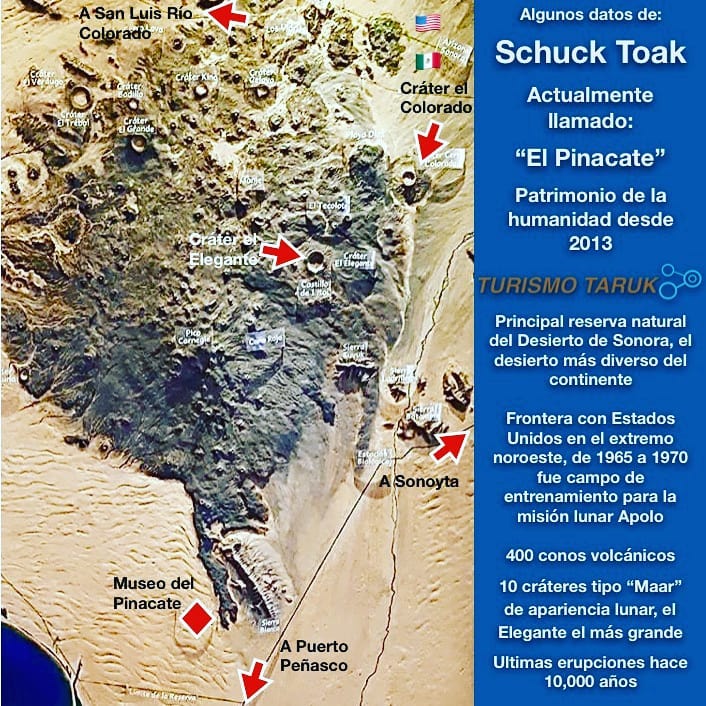
Pinacate Volcanic Fields
Geologist and Volcanologist
The Discovery of Pinacate Volcano
Histories of geology usually credit the recognition of extinct volcanoes far from present volcanic regions to Jean Guettard (1715- 1786) and Nicholas Desmarest (1725-1815), whose thorough studies of the ancient volcanoes of Auvergne have not only become scientific classics, but form the basis of the modern science of volcanology. A few of the more thorough works justly credit Strabo with the observation that Vesuvius, inactive at the time of his visit, was a volcano.
Recent studies of manuscripts in the archives of Mexico, largely initiated by the work of Herbert E. Bolton, have disclosed three narrative accounts [by Kino, Juan María Salvatierra and Juan Mateo Manje] of an exploration of the Sonoran desert region in 1701, during which the Sierra de Santa Clara, now known as the Pinacate peaks, was correctly recognized as a formerly active volcano.
Since the beginning of the present century, the Pinacate region has been studied by workers in several fields of science, and the findings of this early expedition found quite accurate .... [Carl] Lumholtz's descriptions at times agree with those of Kino even to the descriptive analogies used.
Recent studies in the Pinacates, largely the work of the present writer, have produced no major new discoveries, but show quite plainly that the pioneer work of the expeditions headed by Kino was of a high order of accuracy ....
This identification of an extinct volcano in 1701 appears to be one of the first, if not the first, of such reports from North America, so far as can be determined from available literature, and antedates the publication of the works of Guettard and Desmarest, frequently called the pioneers of volcanology, by about half a century.
Dr. Ronald L. Ives
"The Discovery Of Pinacate Volcano"
The Scientific Monthly
March, 1942 Vol. 54 Pages 230 - 237.
Oceanographer and Marine Biologist
The Quest Of The Blue Shells
Tracer techniques, according to almost any "authority," are a recent development, roughly contemporaneous with relativity, atomic fission, and the singing commercial. Certainly, public awareness of this valuable scientific method date from about 1940.
A more careful investigation discloses that tracer techniques were used effectively more than a century ago to indicate sources of pollution of water supplies, to locate primary ore bodies from valley train deposits, and even to determine the direction of travel of the Pleistocene continental glaciers.
The first recorded use of tracer techniques in North America, so far as available records go, occurred slightly more than two and a half centuries ago and was the work of Eusebio Francisco Kino, S. J, a most competent scientist. ...
Using the blue shells of the common abalone, Haliotis linnaeus, as a trace element, Father Kino demonstrated, by rigorous reasoning and diligent field investigation, that there was extensive trade and travel between the Pacific coast, where the abalone occurred, and the desert land of Papagueria, where the abalone shell was present as a "trade item," serving not only as a kitchen utensil, but also as the raw material for many decorative artifacts.
The entire concept of the interrelation of the abalone source, the mode of dissemination of the shells, the occurrence of the shells in Papagueria, and the geographical significance of the whole, apparently occurred to Father Kino in a matter of moments in March of 1699, while returning to Mission Dolores from the country of the Yumas. This he clearly states in his diaries: " ... those blue shells must be from the opposite coast of California and the South Sea, and that by the route by which they had come thence, from there to here, we could pass from here thither, and to California."
Modern psychologists will class this, correctly, as a "flash of insight," the precursor of most important scientific discoveries. Typical, also, is the implied question, "Why didn't I think of this before?" (" ... and still it did not occur to us," ete. ... ) Like most "sudden" discoveries, this one was a long time in gestation. From Father Kino's own diaries we learn that he first observed the blue abalone shells on the Pacific shore of Baja California about December 30, 1684, where he had journeyed as a cosmographer of the Atondo expedition. Here (near the present Boca de San Gregorio, latitude 26° 03' N., longitude 112° 17' w., approximately), at low tide, members of the party noted "shells of rare and beautiful luster, of all colors of the rainbow, everyone of them larger than the largest mother-of-pearl shells." Local Indians used the blue abalone shells as drinking cups.
During the ensuing fourteen years and some months, Father Kino saw and recorded abalone shells in many inland locations, and received gifts of abalone from the Yumas only a few days before their geographical significance became apparent to him.
The long time lapse between first clear evidence and final concept is not at all unusual, and is no reflection on Father Kino's mental processes. Educators, and those concerned with expediting scientific progress, are still wrestling with the problem of rapid acquisition of "background" and reduction of "soak-in time." It is interesting to note, in passing, that none of Father Kino's associates drew any geographical conclusions from the distribution of the abalone shells, although all of them, specifically including Captain Juan Mateo Manje, Kino's military companion on many difficult marches, were men of considerable education and demonstrated intellectual acumen.
A scientific hypothesis, no matter how plausible it may appear, must be rigorously checked by all available methods before it merits wide acceptance. Although Father Kino probably never heard the term "scientific method," he was fully aware of the modi operandi of scientific investigation and promptly set out to prove" his hypothesis. Appreciable parts of his diaries for 1699 and 1700 closely resemble an experimental scientist's notebooks, recording in detail the investigations made and the results obtained. His official correspondence for the same period contains many mentions of the blue shells, their possible significance, and the progress of his inquiries and searches.
The intensity. and thoroughness of this investigation is clearly shown by diary notations. On April 26, 1700, at the rancheria of San Xavier del Bac, Kino writes, "I tried to take and did take measures to find out whether the blue shells came from any other region than the opposite coast of California. To that end I des- patched various messengers in all directions ... to learn with all possible exactness in regard to the blue shells and the passage by land to California."!
While the messengers were en route, Kino and party, with many Indian aides, "began the foundations of a very large and capacious church house and house of San Xavier del Bac" (April 28,1700).
Soon the various queries began to get results. At a night assemblage and conference on April 30, 1700, Kino "made further and further inquiries as to whence came the blue shells, and all asserted that there were none in this nearest Sea of California (the Gulf of California), but that they came from other lands more remote." The next day, May 1, 1700, saw the arrival of many 'Justices, captains, and governors" from the west, and conferences were continued again far into the night. Among the subjects covered were "various inquiries in regard to the blue shells which were brought from the' northwest and from the Yumas and Cutganes, which admittedly came from the opposite coast of California and from the sea which is ten or twelve days' journey farther than this other Sea of California, on which there are shells of pearl and white, and many others, but none of those blue ones which they gave us among the Yumas .... "
From the accumulated evidence, of which the foregoing quotations are only a small part, Father Kino drew the following conclusions:
1. That the blue abalone shells occur only on the shores of the South Sea (Pacific Ocean), and that they do not occur in the nearer Sea of California (Gulf of California).
2. That all of the blue abalone shells found in Papagueria were brought in from the west by Indians, who traveled overland.
3. That the western shore of California was ten to twelve days' journey (afoot) west of the country of the Yumas.
As a direct result of these conclusions, Kino immediately dropped his plans to complete a boat at Caborca, planned for the sea exploration of the upper part of the Sea of California, and drew up plans for an overland search for the much-to-be-desired land passage to California. The first change of plans undoubtedly pleased Kino's superior Father Mora greatly; about the second he was dutifully silent.
The findings in regard to the blue shells, samples of the shells themselves, and the rigorously tested hypothesis that there was a passage by land to California were all communicated rapidly to Kino's ecclesiastical superiors and co-workers, eliciting, in most in- stances, enthusiastic replies accompanied by the hope that a land exploration would soon be made.
These expeditions were made, and the records of them form an important and impressive chapter in the history of American exploration. Most widely known result of these investigations was Kino's famous and beautiful map, "Paso por Tierra a la California," dated 1701. The most important expedition, geographically, was that made between February 5, 1702, and the middle of April of the same year, by Father Kino in company with Father Rector Manuel Gonzales. Traveling by way of Sonoyta and the Camino del Diablo, the two fathers reached the western shore of the Gulf of California and watched the sun rise over the Gulf on the morning of March 11,1702.
Misfortune dogged the return journey from the head of the Gulf. The first eastward attempt, made directly across the medanos toward Pinacate, failed for lack of water and high winds, necessitating difficult backtracking to the longer route via Yuma." At Sonoyta, Father Gonzales, who had embarked on the journey suffering from a "painful flux" of long standing, became too ill to ride farther, and was carried in a litter borne by Papago volunteers, from Sonoyta to Tubutama. There, despite the best medical efforts of all concerned, he died sometime after April 8, 1702, and before April 17, of the same year. With his death Father Kino lost not only an old and valued friend and sympathetic superior, but also a much-needed "official witness" to his discoveries.
The "official" demonstration of the peninsularity of California took place in the fall of 1706, when Father Kino took a party of observers to the Sierra of Santa Clara (Pinacate) and showed them the lands visible at the head of the Gulf, including "the great sandy beach where the sea ends," The night of November 5-6 was spent atop the Pinacates, and observations were continued the next morning. The joint report of the expedition ... signed by Father Kino, and Fray Manuel de la Oyuela y Velarde, Alferez Juan Mathea Ramirez, and squadron commander Juan Antonio Duran, indicates that all were convinced of the peninsularity of California. Also interesting is the separate certification of the same facts by Fray Manuel de la Oyuela," who apparently was much impressed by Sonoran progress.
So far as Father Kino and the official witnesses were concerned, the peninsularity of California, first indicated by the origin and distribution of the blue abalone shells, was now conclusively proven. Some geographers accepted these findings almost immediately; others stubbornly cherished the legendary "Island of California" and "Strait of Anian" for almost a century more.
Here we have, in greatly abbreviated form, the history of a very successful scientific investigation completed a quarter of a millennium ago. Unlike many "old" studies, this one, being entirely correct, has stood the test of time, and today's maps, although containing more detail, look much like Kino's.
Critical review of the entire investigation, using all available modern knowledge, which contains perhaps 10,000 times as many pertinent facts as were available to Father Kino, shows plainly that the ancient study was not only successful, but also sound and competently conducted.
Father Kino's choice of the abalone shell as a tracer was most fortunate, for it is a unique shell, easily identifiable and not likely to be mistaken for anything else ....
The abalone today occurs in the Pacific coastal waters from central Oregon to central Baja California, and in no other North American waters. Paleontological studies show that the range of the abalone has been quite stable in Pleistocene and recent times, despite known changes in sea levels, ocean currents, and ocean temperatures, particularly during the Ice Ages. The first Californians of whom we have records found the abalone in about the same places where we find them today. This we know to be true, for abalone shells and shell fragments are found in the oldest shell middens of the California coasts.
As Father Kino correctly noted more than two and a half centuries ago, the abalone does not occur in the waters of the Gulf of California. Studies of ancient beaches and fossil shell deposits along the shore of the Sea of Cortez disclose no evidence or suggestion that the abalone ever did live there. In consequence, we can _ state with great confidence, as did Father Kino just before 1700, that any abalone. shells found in Papagueria "must be from the opposite coast of California and the South Sea .... "
Abalone shells were a popular "trade item" among the American Indians, as is clearly shown by the Kino documents and many related early accounts. Extensive archaeological investigations in recent years have shown that abalone shells were traded eastward from the California coast to numerous sites east of the Mississippi. The same students indicate that this trade continued for consider- ably more than 1,000 years before Kino's time ....
Interestingly, abalone shells are still a trade item, many visitors to California coastal areas purchasing one or more, which ultimately find their way to points as far distant as the Atlantic coast. Archaeologists of the far future may be sorely puzzled at the inter- deposition of abalone shells with the vacuum tubes and Coca Cola bottles in the middens of the primitives of the Fourth Interglacial!
Because many of our modern trade and travel routes approximate those used by the Indians,• going from water hole to water hole in desert areas and over the smoothest terrain in those well- watered, the trajectory of the traded abalone shell has changed little in the last 1,000 years, although the speed of dissemination has increased greatly.
Thus it appears that Father Kino's pioneer use of ecological tracers-the "blue shells"-was not only a successful and competently conducted study in his time, but must still be regarded as a brilliant scientific investigation, worthy not only of mention, but of careful study, after a lapse of a quarter of a millennium!
Ronald L. Ives
"The Quest Of The Blue Shells"
Arizoniana
Arizona Historical Society
Spring 1961 Volume 2 Pages 3 -7
Natural Historian
Biological exploration in Baja California with a clear scientific purpose and a systematic approach began in 1683 when the Jesuits visited the peninsula for the first time. .... In 1683 he [Kino] visited the Bay of La Paz .. ... In 1684–1685 he organized a third expedition to the peninsula, in which he crossed the peninsular ranges north of the Cerro de la Giganta from the estuary of San Bruno to the oasis of La Purísima and to the Pacific coast. In his notes of this trip (Kino 1685) he described in good detail the landscape and vegetation of the peninsula.
Pedro P. Garcillán, Charlotte E. González Abraham, and Exequiel Ezcurra
"The Cartographers of Life: Two Centuries of Mapping the Natural History of Baja California"
Journal of the Southwest
Spring 2010
Editor Note: The description of the first European crossing by land of the Baja peninsula is in "First from the Gulf to the Pacific; The Diary of the Kino-Atondo Peninsular Expedition, December 14, 1684 - January 13, 1685" translated by W. Michael Mathes.
For more about Kino's exploration of Baja California, click
California Founder Page
Doctor and Pharmacist
Second only to his work as a missionary, Kino was a doctor and pharmacist
For more information, click
Missionary Page
Agriculturist
For more information about Kino as agricultural scientist, click
Farmer Rancher Page
Horseman Page and
Kino Wheat Page
Cartographer
For information about Kino's contributions to world cartography, click
Cartographer Page
Jesuit Tradition of Scientific Inquiry
A remarkable characteristic of the Society of Jesus during the period of its first founding (1540-1773) was the involvement of its members in the sciences.
The reasons for this interest in scientific study can be found in the nature and mission of the order itself. Saint Ignatius Loyola considered the acquisition of knowledge and the performance of mundane labor as spiritually profitable tasks, and this fostered in the Society an action-oriented, utilitarian mentality sympathetic to scientific study. In addition the role of the Society as the "schoolmasters of Europe" meant that the pedagogically (and scientifically) useful principles of rationality, method, and efficiency were highly valued.
The tight-knit organization of the Society created among its members habits of cooperation and communication, essential for the gathering and exchange of scientific information. Finally, mission work in Asia and the Americas gave the Jesuits opportunities and impetus to study and record the phenomena of these new worlds.
Jesuits and the Sciences 1540 - 1999
Loyola University Chicago
Digital Special Collections - Exhibits
http://www.lib.luc.edu/specialcollections/exhibits
"Jesuits As Science Missionaries"
For background on the Jesuit scientific tradition from the Jesuit's beginnings to the present, click
https://theconversation.com/jesuits-as-science-missionaries-for-the-catholic-church-47829
Science 2.0
September 27, 2015
Accessed:November 27, 2015
